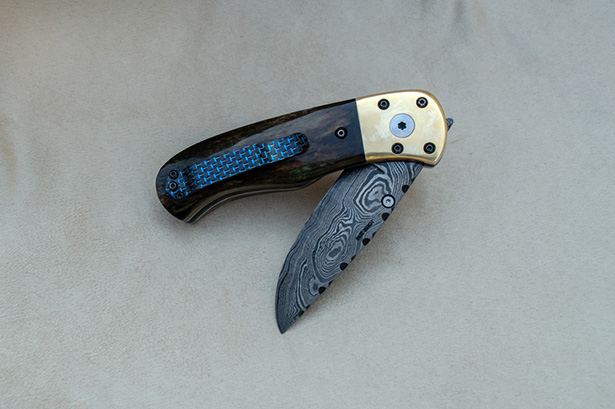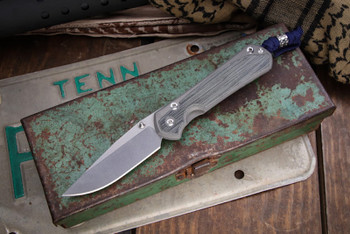How to Build a Pocket Knife Display Case for Your Collection
Apr 9th 2019

Why leave your pocket knives to collect dust inside drawers when they can be properly displayed to showcase your enthusiasm for these amazing tools? A display case can add a personalized aesthetic touch to your home while protecting pocket knives and valuable custom knivesfrom rust or mildew. Best of all, these display cases are simple and inexpensive to make. Here are easy step-by-step instructions so you can build the perfect place to store and display your pocket knife collection.
1. Prepare the backboard
To determine what size backboard you’ll need, gather all the knives you want to display and arrange them on a large sheet of paper, such as a newspaper, as you would have them in the case. Mark a rectangle that encloses all the knives with at least a one-inch border around the edges for the frame.
When you have the correct measurements for the backboard, you can head to the hardware store to pick up an MDF or plywood board in the proper size. Composite wood is good to use for the display case backing because it is lightweight and inexpensive. The appearance of the wooden backing isn’t so important because you’ll cover it with fabric.
Browse Our Collection of Microtech Knives
You can pick up fabric from a craft store or large convenience stores. Add at least two inches to the length and width of the rectangular backing so you have enough fabric to cover the front and fold over the edges to the back. You can use staples or wood glue to secure the overhanging fabric to the back of the wooden board.
2. Decide how the knives will be held

It is important to decide how to display knives in your collection, as the way they are held in the display can have a large impact on the final look of the case. You can hold the pocket knives in place using foam board on the backing, adding pegs or shelves or running strings across the case.
If you choose the foam option, you can skip the upholstery step and simply glue a foam board onto the plank, leaving space for the frame. Next, whittle indents for your pocket knives to sit in.
You can easily add pegs to the backboard to support your pocket knives by cutting wooden dowels into one-and-a-half-inch segments and securing them with screws to the backboard. You will need to pre-drill holes in the backing and dowels before adding the screws to prevent the wood from splitting.
Shelves are another way to neatly arrange your knives in the case. Use a one-by-two-inch board to run the horizontal length of the backing and secure with screws in pre-drilled holes. You can add as many shelves as you like to comfortably house your entire collection.
Running string or twine across the face of the backing is the simplest way to support your knives in the case. Secure the string to the back of the case using staples and then display your knives half-deployed by hanging them from the string.
3. Frame the backboard
Once you’ve finished building the mechanism to keep your knives in place when the case is hung, you’re ready to build the case frame. You can use a one-by-two-inch or one-by-three-inch board to cut the appropriate dimensions to frame the backing.
With the proper tools, you can cut diagonal edges on the framing boards to create a professional-looking corner. Otherwise, simply continue one board to the edge of the frame and create a square corner with an overlapped effect. Secure the frame with screws.
Depending on the surrounding furnishings of your home, you can stain or paint the frame to create a display case that matches your style. Stain or paint the wooden boards after cutting them to size, but before attaching them to the backing.
4. Attach hanging hardware

If you plan on mounting your display case on the wall, now is the time to attach hanging hardware. Large sawtooth hangers or triangular ring hangers are ideal for display cases. Attach one hanger on each side of the case to safely mount your case on the wall.
5. Add glass
A glass covering over your display case will give it a professional finish while better protecting your custom knives from humidity and debris. To add glass, glue or screw wooden glass retainers to the inside of the frame. This will allow the glass to fit snugly inside the frame without needing to drill holes in the glass.
Depending on how accessible you want your knives to be, you may decide to add a lid to the display case. You can connect the lid to the frame with hinges and a clasp so you can easily access the knives. If you are displaying specialty knives–like custom automatic knives or Microtech knives–you can add a lock to the glass door to protect your investment.
6. Display your handiwork
A handmade pocket knife storage case is a beautiful way to arrange and exhibit your collection. Making the case yourself allows you to create a piece that works perfectly with your knives and the existing décor of your house.
Call us at (423) 525-9477 to talk with our knowledgeable staff about adding quality knives to your collection or browse our blog for tips on how to care for your knives.
Check Out Our Assortment of Custom Knives for Sale
.ctaBtn {background:#000;color:#fff;display:table;margin:0 auto;padding:20px;font-weight:700;border:1px solid #000;text-align:center;text-decoration:none;}.ctaBtn:hover {background:#fff;color:#000;}

